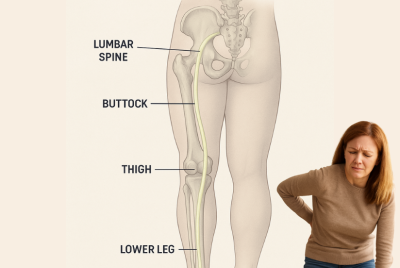Best Exercises for Sciatica
Your Guide to Pain Relief and Strengthening
Find the best exercises for sciatica relief. Learn stretches and strengthening moves to ease pain and improve mobility in daily life. Living with sciatica pain can be tough, but I’m here to share some exercises that have been shown to provide real relief. If you’ve been struggling with discomfort and stiffness caused by sciatica, these exercises can help you stretch and strengthen the affected areas. Let’s dive into an easy-to-follow exercise plan to help relieve your sciatic pain.
Understanding Sciatica and Its Causes
What is Sciatica?
Sciatica is a type of nerve pain that runs along the sciatic nerve, which extends from the lower back through the hips and down each leg. When this nerve is irritated or compressed, you can experience pain, tingling, or even numbness in these areas.
Why Sciatica Pain Happens
Sciatica pain typically arises from issues such as herniated discs, spinal stenosis, or piriformis syndrome. These problems put pressure on the sciatic nerve, triggering symptoms that can range from mild discomfort to intense pain.
How Exercises Help Relieve Sciatica
The Role of Exercise in Sciatica Relief
Exercise plays a crucial role in managing sciatica. When you stay active and focus on gentle, specific exercises, you can reduce pressure on the sciatic nerve and strengthen the muscles that support your spine. This relieves pain and promotes overall health.
Benefits of Targeted Exercises for Sciatica
Targeted exercises help with muscle flexibility, improve circulation, and reduce inflammation around the sciatic nerve. They also contribute to better posture, which can alleviate nerve pressure.
Essential Guidelines Before Starting Sciatica Exercises
Consult with a Healthcare Professional
Before beginning any new exercise routine, especially for sciatica, consult with a healthcare professional. They can help determine the best approach for your specific condition.
Warm Up and Listen to Your Body
Warming up before exercises can prepare your muscles and joints, helping prevent injury. Also, remember to listen to your body. If any exercise increases your pain, it’s best to stop and consult your doctor.
The One Exercise You Must Do For Sciatica Pain Relief
Best Stretching Exercises for Sciatica Relief
Stretching is essential for relieving sciatica symptoms, as it helps improve flexibility and reduce muscle tension around the sciatic nerve.
Seated Piriformis Stretch
The piriformis muscle is close to the sciatic nerve, and stretching it can relieve pressure on the nerve.
- Sit on the floor with both legs extended.
- Cross your affected leg over the other.
- Twist your torso toward the crossed leg and hold for 30 seconds.
- Repeat on the other side.
Knee-to-Chest Stretch
This gentle stretch helps relieve lower back pressure and relaxes the glutes.
- Lie on your back and bring one knee up to your chest.
- Hold for 20-30 seconds and switch legs.
- Repeat two to three times.
Reclining Pigeon Pose
This yoga pose stretches the glutes and lower back.
- Lie on your back and bring one ankle over the opposite knee.
- Hold onto the thigh of the supporting leg and gently pull it toward you.
- Hold for 20-30 seconds and switch sides.
Cat-Cow Stretch for Flexibility
The Cat-Cow stretch helps improve spinal flexibility and reduce tension.
- Start on your hands and knees.
- Inhale, arch your back (cow pose), and exhale while rounding it (cat pose).
- Repeat for 30-60 seconds.
Strengthening Exercises for Sciatica
Strengthening the core, glutes, and lower back can provide essential support to the spine and ease sciatic pain.
Pelvic Tilts for Core Stability
Pelvic tilts engage the lower abdominal muscles, relieving back pressure.
- Lie on your back with your knees bent.
- Flatten your lower back against the floor and tighten your core.
- Hold for a few seconds, then release. Repeat 10-15 times.
Bird Dog Exercise for Balance and Stability
This exercise stabilizes the spine and strengthens core muscles.
- Start on your hands and knees.
- Extend one arm and the opposite leg simultaneously, keeping your back straight.
- Hold for a few seconds, then switch. Repeat 8-12 times per side.
Glute Bridges for Lower Body Strength
Strengthening the glutes can relieve lower back pressure.
- Lie on your back with your knees bent and feet flat on the floor.
- Lift your hips until your body forms a straight line from shoulders to knees.
- Hold for a few seconds, then lower. Repeat 10-15 times.
Low-Impact Aerobic Exercises to Manage Sciatica
Low-impact exercises increase circulation and reduce inflammation without straining the sciatic nerve.
Walking as a Gentle Relief Method
Walking is an excellent low-impact exercise for managing sciatica. It promotes blood flow, reduces inflammation, and gently stretches the lower back and leg muscles, easing pressure on the sciatic nerve. Aim for 20–30 minutes of brisk walking daily to help relieve pain and improve mobility. Remember to maintain good posture to avoid additional strain on your back.
Swimming for Full-Body Relief
Swimming is ideal for sciatica relief. It offers a full-body, low-impact workout that reduces stress on the spine and joints. The buoyancy of water supports your body, allowing gentle stretching and strengthening without putting pressure on the sciatic nerve. Try swimming or water aerobics for 20–30 minutes a few times a week to help alleviate pain and improve flexibility.
Tips for Practicing Sciatica Exercises Safely
Don’t Push Through Pain
Practicing sciatica exercises safely means respecting your body’s limits—don’t push through sharp or intense pain, as this can worsen symptoms. Some discomfort or mild soreness is normal, but severe pain may indicate strain on the sciatic nerve or other muscles. Start with gentle stretches and low-impact exercises, gradually increasing intensity as tolerated. Use proper form to prevent injury, and prioritize quality over quantity. Listen to your body: if a movement feels painful or uncomfortable, stop and adjust. For best results, focus on consistent, moderate practice, and consult a professional if you’re unsure about any exercise.
Maintain Consistency for Lasting Relief
Consistency is key to achieving lasting relief from sciatica through exercise. Regularly practicing sciatica-specific stretches and strengthening exercises can help reduce nerve pressure, improve flexibility, and build muscle support for your spine. Aim to exercise at least 3-4 times per week, gradually incorporating it into your daily routine. Consistency helps your body adapt to the movements, reducing inflammation and easing pain over time. Skipping sessions may slow progress, but steady practice builds strength and resilience. Remember, relief takes time, so be patient and committed for the best results. If unsure, consult a professional for tailored guidance.
When to Avoid Certain Sciatica Exercises
Certain sciatica exercises should be avoided if they cause sharp pain, worsen symptoms, or increase inflammation. High-impact exercises, such as running or heavy lifting, can aggravate the sciatic nerve, especially in acute cases. Twisting movements and deep forward bends may also place extra stress on the lower back and hips, potentially worsening nerve compression. Individuals with herniated discs, spinal stenosis, or other spine-related issues should avoid exercises that strain the lower back. If sciatica symptoms worsen during or after exercise, it’s best to stop and consult a healthcare professional to modify the routine for safer, pain-free options.
FAQs Related to Best Exercises for Sciatica
Are there any sciatica exercises to avoid?
Avoid exercises that involve heavy twisting, bending, or high-impact movements, as these can worsen sciatic pain. Always consult a professional if you’re unsure.
How often should I do these exercises?
Start with these exercises three times a week, then gradually increase to daily as you build strength and flexibility.
Is walking enough to reduce sciatica pain?
Walking can help relieve mild sciatica, but incorporating stretches and strength exercises can provide more comprehensive relief.
Can strengthening exercises worsen my sciatica?
If done incorrectly or with too much intensity, they could. Always use proper form and avoid pushing through pain.
How long before I feel relief from these exercises?
Most people notice improvement within 2-4 weeks with consistent practice.
Can stretching alone cure sciatica?
Stretching can help alleviate sciatica symptoms, but it’s usually best when combined with other treatments, such as strength exercises, physical therapy, and lifestyle changes. For the best result, start with this stretching.
Best Exercises for Sciatica – Conclusion
If you’re dealing with sciatica, these exercises can offer real relief by reducing pain and building strength. Remember, relief won’t happen overnight, but staying consistent and listening to your body can make a world of difference. Start slowly, track your progress, and consider speaking to a healthcare provider for further advice.
Disclaimer
Please note that this article should not replace professional medical advice. Consult a healthcare professional for an accurate diagnosis and tailored treatment plan.






